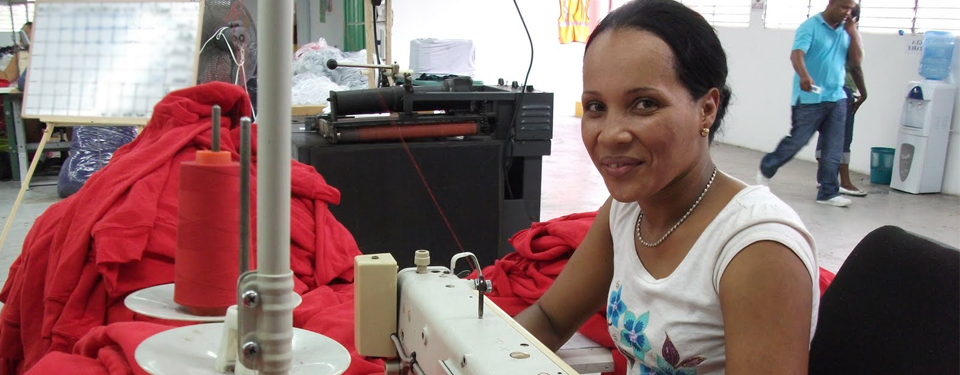Elves Didn’t Make Your Shoes
Alternatives to Sweatshops

The last time I believed that a jolly man with a big beard and a red suit was sliding down my chimney on Christmas eve was also the last time I knew exactly where my clothes were made. They were made in the North Pole by delightful little elves eating candy canes year-round. I have since come to the realization that Santa Claus isn’t real and along with that realization have come to a few others: my parents had to pay their hard-earned cash for all of the presents under the tree, including my three-piece burgundy suit. But for some reason, I never thought of who was making those clothes if not the elves.
Somewhere along the road of painful adult realizations, I have come to dreary one that a Dickensian toiling is involved in the textile industry. For most clothes, the detailed answer to their origin is almost always complicated, frequently horrendous, and rarely includes whistling while working.

Most of us have a concept of a “sweatshop.” We also might think that this term is outdated and that since we don’t hear about them so often, we don’t need to worry that our clothes may be coming from them. But recent headlines about labor violations of workers making Apple products have reminded the American public that even our favorite, most innovative brands take advantage of poor, un-unionized workers.
We think about sweatshops less because factories have gotten better at hiding abuses. There are still an estimated 211 million children between the ages of five and fourteen employed in developing countries.
According to Businessweek, in an article entitled “Secrets, Lies and Sweatshops” the average worker in China earns 64 cents an hour and is required to work at least 40 to 60 hours a week, and often forced to work 100-hour weeks.
The website Globalexchange.org reveals that a worker in El Salvador will earn 24 cents for an NBA jersey sold in the United States for $140. We cannot pretend that this wage is sufficient to live on, even taking exchange rates and purchasing power into consideration.
One false conception about sweatshop labor is that it is justifiable because workers appreciate their jobs. This line of argument is just a way of legitimizing the absurd in order to obscure corporate avarice. It operates under the assumption that extreme exploitation is a given. In essence, it asks consumers to become accomplices in human rights abuses every time we go shopping. This rationalization for misery encourages consumers to take smug satisfaction in our role sustaining the worst jobs in the world.
If spending money is like voting for corporations and the values they uphold – and we think it is – our votes indicate that neither reasonable work hours nor lunch and bathroom breaks are among our values. This focus also moves us away from grasping something very important to realize: Humane working conditions are possible.

Many countries allowed workers to unionize until pressure from American corporations forced suppliers to ban any union organization. Because workers are denied unions, they are also denied a voice to speak out about their working conditions. Workers are required to work until they meet their quotas. Quotas are set at such high numbers that workers must assemble one garment in under a minute and sometimes more. Sweatshop labor is not an acceptable alternative to humane working conditions and being able to afford basic necessities such as food, water, and shelter without going into debt.
The Occupy Wall Street Movement has brought it to the general consciousness that a lack of money is not the reason people are struggling financially on a global scale. There is more to the story than that brands simply cannot afford to pay their workers more. The CEO of Reebok retired with a $300 million pension, with which he generously built a golf course for the people of his wealthy New York neighborhood to enjoy. His workers made pennies, and for them a pension is unheard of.
Are consumers so tight-fisted that they are unwilling to part with a few extra cents per garment to make laborers’ wages higher? The answer to that is a graceful “No.” A study recently released by Harvard University shows that consumers are willing to pay more to buy a piece of clothing made under fair labor conditions.
With all of the bad news, I offer you a shred of good news. There is an alternative to sweatshop labor. The name of the factory is Alta Gracia and is located in the Dominican Republic. Workers at Alta Gracia earn three times the minimum wage. Textile workers, for the first time in the globalized world’s history, can afford to escape the poverty cycle. They can pay their bills, they can stay out of debt, they can send their kids to school. A wage that has been adjusted for real living costs is called a ‘living wage.’ To date, Alta Gracia is the only factory in the world that pays a living wage. When one sector of a community does well, it has a strong multiplying effect: other businesses can begin to thrive. In the community of Alta Gracia, people can now afford roofers to re-roof their homes. They can afford to buy lunch at a diner across the street from the factory. That means employment for the roofers, employment for the restaurant owners, and for the people who sell them their cooking gas.
Solutions to sweatshops are possible and must begin at the consumer level. Brands need to be held accountable for the factories where their garments are assembled. As of now, there are very few shops that can boast living-wage clothing for sale. The UCSB bookstore is one retailer selling Alta Gracia clothing. If you are on a sports team that requires T-shirts, or a screen printer looking to source living wage garments, ethixmerch.com can supply Alta Gracia to you at wholesale prices.
UCSB students will be participating in a mock sweatshop sewing in solidarity with the millions of workers who create our clothing during Human Rights Week on , Wednesday, February 29th. Students will be selling Alta Gracia T-shirts printed with a B for blue labor. (“Blue” is to labor what “green” is to the environment). Students will be sewing on their own blue tags to denote that the garments were made by the hands of those earning a living wage.
To learn more about the consumer’s ability to transform the global apparel industry into a more equitable network, visit USAS-UCSB on Facebook. “Like” the page to receive updates and articles, or to join an anti-sweatshop coalition. The networks for global interconnectedness have already been forged by multinational corporations. It is now time for consumers to demand that through these networks of supply chains, wages and standards are drastically elevated so the garment laborer members of the global community can afford not just to survive, but thrive.



